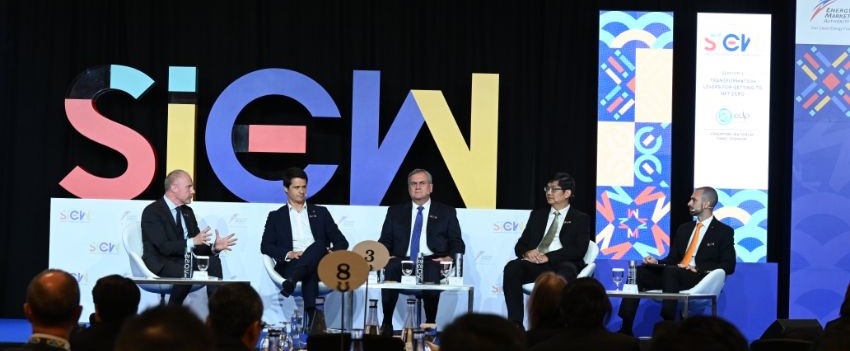A holistic portfolio of transformational levers, underpinned by effective partnerships, will be key to achieving a net zero future. Alika Koh and Linda Zeng report

Ir Jisman Parada Hutajulu and Chantho Milattanapheng took centre stage at the Singapore-IEA Forum on 27 October, offering enlightening keynotes that unveiled the transformational levers steering Indonesia and Laos, respectively, on a course towards a net zero future.
Ir Hutajulu left no room for doubt when he said that "achieving net zero emissions is a complex goal that requires the implementation of various policy frameworks and strategies at the national, regional, and global level".
Both keynotes, presented during Session 2: Transformation Levers for Getting to Net Zero, highlighted the holistic portfolio of levers embraced by their respective countries. Indonesia, for instance, is actively pursuing the early retirement of its coal-fired plants, supported by the Energy Transition partnership. The country also utilises financial instruments such as cap-and-trade systems and carbon levies, in addition to regional interconnectivity initiatives. It is worth noting that each country's approach is tailored to their unique circumstances, shaping their individual portfolios of transformational levers.
The panel session that followed also echoed these sentiments, highlighting that each country’s portfolio of levers will vary according to their different circumstances.
H.E. Mattias Frumerie, Chief Climate Negotiator, Kingdom of Sweden, shared his country's three-pronged approach to the transition, a model that is universal enough to be adapted by other nations.
He identified three core elements: "The approach we take in our Swedish economy is clearly based very much on three different types of elements which can build a good environment for all countries. And those would be policy, finance, and technology."
Elaborating further, in the case of:
- Policy: policy and regulatory frameworks help set the stage for a country's investment climate, signalling to businesses where a country is heading.
- Finance: the provision of capital support for developing countries becomes the cornerstone of progress. The creation of green taxonomies and regulatory accounting standards emerge as essential tools to measure businesses’ impact on climate action.
- Technology: innovation becomes the driving force behind transformative solutions that help propel the energy transition.
These elements work together synergistically and necessitate collaborations, including public-private partnerships. As an example, he mentioned the Leadership Group for Industry Transition launched by Sweden and India in 2019, and supported by the World Economic Forum. This initiative, set up to create industry-specific transition roadmaps, is to accelerate the transition of heavy industries to net zero emissions by 2050.
Making public-private partnerships work
Eric Arnold, Executive Chairman, Global Energy Storage, and Brandon Chia, Managing Director Southeast Asia & Australia, SP Group, both offered insights into enhancing the effectiveness of public-private partnerships.
Mr Arnold, representing the infrastructure sector, said: "We are infrastructure people, we are not decision-makers. We are the foot soldiers of what needs to happen next. It is a frustrating position to be in. We are sitting on a pile of committed capital that we'd love to deploy."
He stressed the need for clarity in certain sectors such as shipping, where both end-users and governments must provide greater clarity on their preferred energy technologies.
Mr Chia highlighted that in public-private partnerships, both parties had a role to play. He cited SP Group's success in articulating the benefits of District Cooling, and credited the Singapore government for understanding and mandating this technology for businesses.
It was also clear that these partnerships need to commence on a smaller scale and demonstrate tangible benefits, before governments feel confident enough to work with industry partners on larger projects.
Strength in diversity
Mr Pedro Vasconcelos, Chief Executive Officer, EDP Renewables Asia Pacific, noted that each country faces its own unique problems on the path to net zero. For example, the US faced supply chain constraints in getting Chinese solar panels. In Europe, connectivity issues prevented large capacities of renewables from reaching end-users.
However, these challenges also offer opportunities for collaboration. Mr Vasconcelos highlighted the potential for greater regional interconnectivity in Southeast Asia, fuelled by Indonesia and Vietnam's significant wind and solar potential and Singapore's off-taking capabilities.
Clear direction forward
The panellists and keynote speakers found common ground regarding the essential transformational levers needed to pave the way for a net zero transition.
Policy, finance, and technology must work in harmony in which each element enhances the other. When these three pillars align, the positive effect is manifold.
Furthermore, these three elements must be supported by effective public-private partnerships. Businesses play a pivotal role by clearly articulating the value of their solutions, while governments must lean forward to grasp the technical intricacies. This should be bolstered by suitable policy and regulatory frameworks to facilitate the smooth adoption of industry solutions.